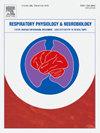Pulmonary stretch receptor modulation of synaptic inhibition shapes the discharge pattern of respiratory premotor neurons
IF 1.6
4区 医学
Q3 PHYSIOLOGY
引用次数: 0
Abstract
Many studies focus on the mechanisms of respiratory rhythm generation through neuronal interactions in the preBötzinger and Bötzinger complex area. There is limited insight into how the varied discharge patterns of propriobulbar, rhythm generating neurons are integrated to generate the slowly augmenting and decrementing discharge patterns observed in respiratory premotor neurons. Neuronal discharge patterns were obtained, in vivo, from inspiratory (I) and expiratory (E) premotor neurons in the ventral respiratory group of adult, anesthetized and vagotomized canines. Electrical activation of vagal afferents was used to produce pulmonary stretch receptor (PSR), step-input patterns, throughout or within either the I- or E-phase. PSR inputs decreased the discharge pattern slopes of augmenting and decrementing E-neurons and increased the slopes of augmenting and decrementing I-neurons. PSR inputs that were applied only for part of the phase acutely changed the discharge pattern to the trajectory associated with those PSR throughout-phase inputs, but the pattern returned immediately to the original trajectory after the PSR input terminated. These types of responses can be reproduced with high fidelity by a mathematical model based on reciprocal inhibition between augmenting and decrementing neurons of the same respiratory phase. Best fit is achieved when PSR inputs solely modulate the strength of the synaptic inhibition of decrementing neurons by augmenting neurons at the presynaptic level. Leaky integrator functions are not necessary to generate the gradually augmenting and decrementing patterns. This model offers a novel and different mechanistic way to conceptualize the generation and PSR control of respiratory discharge patterns.
肺牵张受体对突触抑制的调节影响呼吸前运动神经元的放电模式。
许多研究集中在通过preBötzinger和Bötzinger复杂区神经元相互作用产生呼吸节律的机制上。关于本体球、产生节律的神经元的各种放电模式如何整合以产生呼吸前运动神经元中观察到的缓慢增加和减少的放电模式的见解有限。对麻醉和迷走神经切除的成年犬腹侧呼吸组的吸气(I)和呼气(E)前运动神经元进行体内放电模式分析。迷走神经传入的电激活被用来产生肺伸展受体(PSR),在整个或在I期或e期内的阶跃输入模式。PSR输入降低了递增和递减e神经元的放电模式斜率,增加了递增和递减i神经元的放电模式斜率。仅用于部分相位的PSR输入急剧改变了与这些PSR全相位输入相关的放电模式轨迹,但在PSR输入终止后,该模式立即返回到原始轨迹。这些类型的反应可以通过基于相同呼吸相的增加和减少神经元之间的相互抑制的数学模型以高保真度再现。当PSR输入仅通过在突触前水平增加神经元来调节突触抑制减弱神经元的强度时,达到了最佳拟合。漏积函数对于生成渐增和渐减模式是不必要的。该模型提供了一种新颖而不同的机制方式来概念化呼吸放电模式的产生和PSR控制。
本文章由计算机程序翻译,如有差异,请以英文原文为准。
求助全文
约1分钟内获得全文
求助全文
来源期刊
CiteScore
4.80
自引率
8.70%
发文量
104
审稿时长
54 days
期刊介绍:
Respiratory Physiology & Neurobiology (RESPNB) publishes original articles and invited reviews concerning physiology and pathophysiology of respiration in its broadest sense.
Although a special focus is on topics in neurobiology, high quality papers in respiratory molecular and cellular biology are also welcome, as are high-quality papers in traditional areas, such as:
-Mechanics of breathing-
Gas exchange and acid-base balance-
Respiration at rest and exercise-
Respiration in unusual conditions, like high or low pressure or changes of temperature, low ambient oxygen-
Embryonic and adult respiration-
Comparative respiratory physiology.
Papers on clinical aspects, original methods, as well as theoretical papers are also considered as long as they foster the understanding of respiratory physiology and pathophysiology.

 求助内容:
求助内容: 应助结果提醒方式:
应助结果提醒方式:


